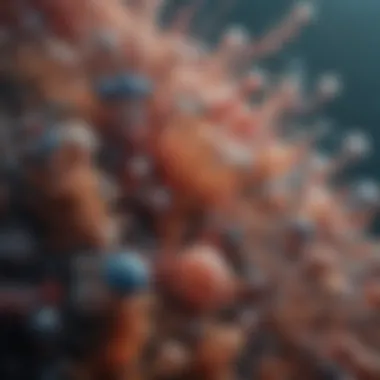Microbiology Today: Advancements and Perspectives


Intro
Microbiology plays a pivotal role in understanding the foundations of life on Earth. Recent advancements in this science reveal new pathways and methodologies that continue to transform various fields, such as medicine, environmental science, and agriculture. With the quick pace of discoveries, it is crucial to highlight the key findings and implications of ongoing research. This overview aims to shed light on these aspects, providing a comprehensive perspective for students, researchers, educators, and professionals.
Key Findings
Microbiological research has yielded several significant results that impact health, ecology, and industry. Here are some core points derived from recent studies:
- Technological Innovations: The advent of next-generation sequencing technologies allows for deeper insights into microbial communities and their functions. This increases the understanding of complex interactions within microbiomes.
- Role of Microbiomes: Research emphasizes that microbiomes significantly influence human health and disease. For instance, the gut microbiome is linked to conditions such as obesity, diabetes, and mental health disorders.
- Environmental Sustainability: Findings point to the potential of microbes in bioremediation and waste management. Microorganisms can degrade pollutants and recycle nutrients, proving essential in sustainable practices.
"Microbiology is at the forefront of addressing global challenges by harnessing the power of tiny organisms to create substantial change."
The significance of these findings within the scientific community is manifold. With advancements in understanding microbiomes, there is a burgeoning interest in tailoring probiotic therapies and developing novel treatments that target specific microbial populations.
Implications of the Research
The applications of the insights gained from microbiological research are vast and varied:
- Healthcare Applications: Therapies based on microbiome manipulation have arisen from recent findings. This could lead to personalized medicine, where treatments are designed based on an individual's microbiome profile.
- Agricultural Impact: Research into plant-associated microbes opens new avenues for developing sustainable agricultural practices. Utilizing beneficial microbes can enhance plant growth and resilience, reducing the dependence on chemical fertilizers.
- Policy and Regulation: Various findings will influence health policies and environmental regulations, pushing for a more microbiome-aware approach in public health and environmental protection.
As we look ahead, ongoing investigations in microbiology will likely shape future research directions. Priorities may include further understanding of microbial resistance to antibiotics, investigating symbiotic relationships in ecosystems, and utilizing synthetic biology to engineer beneficial microorganisms.
Prelims to Microbiology
Microbiology is an essential field of study that uncovers the complex world of microscopic organisms. From bacteria to viruses, this discipline holds profound significance in various areas, including health, ecology, and biotechnology. Within this article, an exploration of microbiology serves to highlight its critical advancements and perspectives. The growing awareness of microorganisms and their roles guides research and application across multiple domains, making their study more relevant than ever.
Definition and Scope
Microbiology involves the study of organisms that are typically too small to be seen with the naked eye. This encompasses a variety of life forms, including bacteria, archaea, fungi, and viruses. The scope of microbiology is broad, connecting to diverse fields like medicine, agriculture, and environmental science. Understanding these organisms is crucial, as they can significantly influence health, disease, and ecosystems. Their impact reaches into food production through fermentation processes and into medicine with antibiotic development and vaccines.
Historical Context
The evolution of microbiology can be traced back several centuries, and it has been shaped by the contributions of key figures whose work laid the foundation for modern understanding.
Key Figures in Microbiology
Anton van Leeuwenhoek, often referred to as the "father of microbiology," was notable for his pioneering work with microscopes. His discovery of microorganisms in the late 17th century shifted perceptions of life forms that existed beyond human sight. Another significant figure, Louis Pasteur, made hefty contributions through his germ theory of disease, which posited that microorganisms are responsible for infection, revolutionizing medical science. These key figures have driven research efforts. Their contributions catalyzed advances that enhanced public health and scientific knowledge.
Milestones in Microbial Research
Throughout history, various milestones in microbial research have marked vital advancements. One major milestone was the development of antibiotics in the early 20th century. Alexander Fleming's discovery of penicillin set the stage for modern medicine, providing a means to treat bacterial infections effectively. Among other key milestones is the advancement of vaccine technology, which has played a crucial role in controlling infectious diseases. These milestones underscore the importance of continuous research in microbiology to address emerging health issues and improve public health strategies.
Current Trends in Microbial Research
Current trends in microbial research represent the cutting edge of the discipline. They reflect our ongoing quest to understand complex microbial systems and their functionalities. As technology progresses, so does our approach towards microbial studies. It is essential to examine these advancements closely. This not only enhances our understanding but also demonstrates how they can be applied across various fields.
Technological Advances
Next-Generation Sequencing
Next-Generation Sequencing (NGS) has revolutionized the way we analyze genetic materials. It allows researchers to sequence entire genomes quickly and accurately. This speed and precision represent a significant evolution from traditional sequencing techniques.
One key characteristic of NGS is its ability to produce vast amounts of data. This capability permits a more thorough examination of microbial communities. NGS is beneficial for identifying new species and understanding evolutionary relationships among microbes. Moreover, it enables researchers to explore microbial diversity in numerous environments, a fundamental aspect of ecological studies.
Despite its advantages, NGS has some disadvantages. The cost of equipment and data analysis can be daunting for smaller labs. Additionally, the interpretation of the extensive data generated requires specialized skills and knowledge.
Bioinformatics Applications


Bioinformatics Applications play a crucial role in microbiology today. By integrating biological data with computational techniques, bioinformatics transforms raw data into meaningful insights. Moreover, it addresses complex questions, such as how microbes interact within ecosystems and their roles in human health.
A striking feature of bioinformatics is its capacity for data integration. This enhances existing datasets by offering valuable perspectives not easily visible in isolation. Bioinformatics is favored because it supports large-scale analyses, generating models and simulations that assist in hypothesis testing.
However, bioinformatics comes with challenges. The dependency on computational resources can increase project timelines. Furthermore, misinterpretation of bioinformatics results can lead to incorrect conclusions, necessitating careful scrutiny.
Synthetic Biology and Microbiology
Gene Editing Technologies
Gene Editing Technologies, such as CRISPR-Cas9, have made significant waves in microbial research. These technologies allow for precise modifications in the genomes of microbial organisms. They are instrumental in creating strains with desirable traits, advancing both basic research and applied science.
The main characteristic of gene editing is its precision. By targeting specific sequences within a genome, researchers can alter or delete genes that affect microbial behavior. This level of control facilitates certain applications, such as developing biofuel-producing microorganisms or enhancing pathogen resistance in crops.
Nonetheless, gene editing raises ethical considerations. The potential for unintended consequences in edited organisms needs extensive assessment. Some argue that alterations to the microbiome could have unpredictable effects on ecosystem dynamics.
Applications in Industry
The Applications in Industry of microbiology are numerous and varied. Industries such as food, pharmaceuticals, and agriculture have embraced microbial technologies to improve their processes. For instance, fermentation technologies not only enhance food preservation but also contribute significantly to flavor profiles and nutrition.
A key characteristic of industrial microbiology is its sustainability. By utilizing microorganisms, industries can often reduce their ecological footprint. Bioprocesses frequently result in less waste and energy consumption compared to traditional methods.
However, these applications also face challenges. Regulatory hurdles can slow down the development of new microbial products. Additionally, the success of microbial applications depends heavily on public perception and acceptance, which can vary widely across regions.
Microbiomes and Human Health
Microbiomes play a crucial role in human health and disease, influencing various physiological processes. The study of human microbiomes has increased in importance as it reveals the intricate relationships between microbes and human hosts. Understanding these relationships can lead to significant advancements in personalized medicine, prevention strategies, and treatment methodologies for various diseases.
The Human Microbiome
Impact on Health and Disease
The human microbiome consists of trillions of microorganisms that reside in areas such as the gut, skin, and oral cavity. It directly impacts health by aiding digestion, protecting against pathogens, and regulating immune responses. An imbalance in this microbial community can contribute to various health issues, ranging from obesity to autoimmune diseases. This aspect highlights the necessity for further research into the microbiome's dynamic interactions with the human body.
- Key Characteristic: The link between microbiomes and metabolic health.
- A balanced microbiome can support healthy weight management.
The unique aspect of the relationship between microbiomes and health is its responsiveness to lifestyle factors, including diet, exercise, and stress. By understanding these factors, it may allow for targeted dietary interventions to improve health outcomes, which is advantageous in this article as it emphasizes proactive health management. However, the challenge remains in how to best manipulate these microbial communities safely.
Microbial Diversity
Microbial diversity refers to the variety of microorganisms present in the human microbiome. This diversity is vital for maintaining a healthy microbiome. Higher microbial diversity correlates with better health outcomes and resilience against disease.
- Key Characteristic: The role of microbial diversity in preventing disease.
- Diverse microbial populations foster a robust immune system and can prevent infections.
The unique feature of microbial diversity is its ability to provide stability to the microbiome. A diverse microbiome can adapt better to environmental changes or disruptions. This is beneficial for the readers by highlighting the importance of dietary and lifestyle choices in supporting microbial diversity. However, individuals with low diversity are more susceptible to infections and diseases.
Probiotics and Prebiotics
Probiotics and prebiotics are significant components in the discussion of microbiomes. Probiotics are live microorganisms that confer health benefits, while prebiotics are substances that enhance the growth of beneficial microbes. Both play an essential role in maintaining a balanced microbiome.
- Probiotics can help restore microbial balance during antibiotic treatment.
- Prebiotics serve as food for beneficial bacteria, promoting their growth.
These elements not only underscore the importance of maintaining a healthy microbiome but also introduce actionable steps individuals can take. By incorporating probiotics and prebiotics into their diets, people can actively support their gut health. However, it is essential to consider the quality and effectiveness of these products, as not all probiotics are equal.
Environmental Microbiology


Environmental microbiology studies the role of microorganisms in the environment. It is critical in understanding the interactions between microbes and their surroundings. This field encompasses many processes that are crucial for ecosystem health, sustainability, and biogeochemical cycles. The rise in environmental concerns has made this area of microbiology increasingly important. Researchers focus on how microbes can help solve environmental problems, such as pollution and resource management. The insights generated here have implications in multiple sectors including agriculture, waste management, and climate change mitigation.
Microbial Roles in Ecosystems
Microorganisms play essential roles in ecosystems. They drive fundamental processes such as nutrient cycling and bioremediation. Understanding these roles can lead to innovations in environmental management.
Nutrient Cycling
Nutrient cycling refers to the movement and exchange of organic and inorganic matter back into the production of living matter. This is vital for ecosystem sustainability. Microorganisms facilitate these processes by decomposing organic matter and returning nutrients to the soil.
Key characteristics of nutrient cycling include:
- Breakdown of dead organic material
- Recycling of nutrients for plant use
- Maintenance of soil health
Nutrient cycling is a popular topic due to its direct impact on agricultural productivity and environmental preservation. A unique aspect of nutrient cycling is its interconnectedness with other ecological processes, ensuring that ecosystems remain balanced. However, there are challenges, such as nutrient runoff, which can lead to water pollution if not managed properly.
Bioremediation
Bioremediation is the process of using microorganisms to remove or neutralize contaminants from the environment. This approach offers a natural solution for cleaning up polluted sites. The characteristic advantage of bioremediation is its ability to harness the natural abilities of microbes.
Key features of bioremediation include:
- Cost-effectiveness compared to traditional cleanup methods
- Minimal environmental disruption
- Versatility, as it can be applied to a variety of contaminants
Bioremediation is an effective and sustainable choice for addressing environmental pollution. One advantage is that it often requires no extensive technology, just the natural processes of microorganisms. However, it may take longer to achieve results compared to conventional methods.
Climate Change and Microbial Responses
Climate change significantly affects microbial communities and their functions within ecosystems. As temperatures rise, microbial metabolism may increase, leading to altered nutrient cycling and greenhouse gas emissions. Research in this area is crucial, as understanding how microbes adapt to changing conditions can inform climate mitigation strategies. Microbes could either exacerbate or mitigate climate effects, depending on the context of their activity.
Studies on microbial responses to climate change provide insights into ecosystem resilience. This knowledge is critical for developing strategies to enhance the role of microbes in maintaining ecological balance under stress conditions.
Microbiology in Industry
Microbiology plays a pivotal role in various industrial applications, transforming raw materials into products that are vital for everyday life. Knowledge in microbiological processes has led to innovative techniques across sectors, notably in food production and pharmaceuticals. By leveraging microorganisms, industries improve efficiency, sustainability, and product quality.
Fermentation Technologies
Food Production
Fermentation in food production is a cornerstone of the culinary world. It involves using microorganisms, such as yeast and bacteria, to convert sugars into acids or alcohol. This technique not only enhances the flavor and texture of food items but also extends their shelf life. For example, yogurt and cheese owe their creation to fermentation processes that rely heavily on specific strains of bacteria.
One key characteristic of food fermentation is its ability to increase nutritional value. The fermentation process can enhance the bioavailability of nutrients, making them easier for the body to absorb. Additionally, fermented foods such as sauerkraut and kimchi offer probiotics that support gut health, further emphasizing their beneficial nature.
However, there are certain considerations within food fermentation. Quality control is essential to ensure that the correct microorganisms are present and active. Any contamination could affect the taste and quality of the final product, leading to potential food safety issues.
Pharmaceuticals
The pharmaceutical industry significantly benefits from microbiological processes. Microorganisms are used to produce antibiotics and other therapeutic agents that are crucial for treating infections and diseases. For instance, Penicillium chrysogenum is the mold responsible for the production of penicillin, the first widely used antibiotic.
A critical feature of pharmaceutical applications is the scalability. Microbial fermentation allows for the large-scale production of compounds at a relatively low cost. This affordability makes vital medications accessible to a broader population, addressing critical health needs globally.
However, there are also drawbacks, including the potential for resistance. The overuse of antibiotics in medicine and agriculture contributes to antimicrobial resistance, posing a significant threat to public health. Addressing this requires ongoing research into alternative therapies and sustainable practices.
Biotechnology Applications
Biotechnology integrates microbiology principles with technology to develop products that solve real-world problems. The applications are diverse, ranging from biofuels to bioplastics and enzymes used in industrial processes. One notable instance is the use of genetically modified organisms in biopharming to produce pharmaceuticals, which demonstrates the expansive possibilities of this field.


The collaboration between biology and technology heralds a future with promising innovations that can reshape various industries. Emphasizing sustainable practices and ethical considerations will be important to ensure societal acceptance and environmental responsibility as microbiology continues to advance in industrial applications.
"Microbiology’s potential to drive innovation in the industrial sector remains largely untapped; it will be essential in shaping future economies."
An understanding of microbiology in industry not only showcases existing benefits but also opens discussions on how we can harness these microorganisms responsibly and efficiently to address global challenges.
Challenges in Microbiological Research
The field of microbiology is not without its challenges. As researchers delve deeper into the complexities of microbial communities and their interactions, multiple issues present themselves, each with significant implications for public health, environmental sustainability, and biotechnological advancements. Addressing these challenges is essential not only for the progression of microbiological knowledge but also for its practical applications in society and industry.
Antimicrobial Resistance
Global Health Implications
Antimicrobial resistance (AMR) stands as a crucial challenge in microbiological research today. The increase of antibiotic-resistant pathogens threatens to reverse decades of medical advancements. This resistance occurs when microorganisms undergo mutations or acquire genes that enable them to survive exposure to antibiotics.
The most alarming aspect of global health implications is the potential for common infections to become untreatable. This heightened risk increases morbidity and mortality rates, leading to prolonged hospital stays and higher healthcare costs. This is particularly important because it transcends national borders, necessitating a coordinated international response.
Key characteristics of AMR include its complexity and rapid evolution. Pathogens can quickly adapt, making it difficult to predict resistance patterns. This unpredictability hampers treatment protocols, complicating efforts to manage infections effectively.
A unique feature of AMR is the multidrug-resistance phenomenon, where pathogens become resistant to several antibiotics simultaneously. This issue presents significant challenges to existing treatment methods and necessitates the development of novel antimicrobial agents. The advantages of addressing AMR through microbiological research include the potential to save lives and reduce healthcare costs. Yet, the disadvantages are apparent, with the growing number of resistant strains causing a public health crisis.
Combating Resistance
Combating resistance involves multifaceted strategies aimed at reducing the prevalence of AMR. Strategies include improved infection control measures, stewardship programs that promote the judicious use of antibiotics, and increased research into alternative therapies.
A key characteristic of combating resistance is the focus on education and awareness, both among healthcare providers and the public. Educating patients about the responsible use of antibiotics is essential, as misuse often contributes to resistance.
One unique aspect of this challenge is the exploration of bacteriophages as an alternative to traditional antibiotics. Bacteriophages are viruses that specifically infect bacteria, potentially offering targeted treatment options. However, while promising, using phages raises regulatory and ethical questions that must be navigated carefully.
The advantages of these approaches lie in the potential for sustainable and effective treatment options. However, the difficulties of developing new therapies and the risk of unforeseen long-term consequences remain pressing concerns. As effective lines of defense are critical in controlling infections, ongoing research is vital.
Ethical Considerations
Ethical considerations in microbiological research are paramount, particularly regarding genetic manipulation and the dual-use nature of certain biotechnologies. Researchers must navigate the fine line between advancing scientific knowledge and ensuring safety and empathy for all living organisms.
The use of CRISPR technology, for instance, raises questions about the appropriateness of gene editing in microorganisms. While this technique can enhance beneficial traits in microbes, it also carries the risk of unintended consequences, such as the disruption of ecosystem balances. Ethical discourse must evaluate the long-term implications of these technologies on human health and environmental dynamics.
Moreover, the accessibility of advanced microbiological techniques globally varies significantly. This disparity raises equity concerns in health care, as not all populations benefit equally from breakthroughs in microbiology. A focus on ethical practices ensures that scientific advancements serve the greater good without disadvantaging vulnerable groups.
Future Directions in Microbiology
The field of microbiology is dynamic and continually evolving. Understanding future directions in this discipline is crucial for several reasons. First, advancements in technology and methodology allow for new insights into microbial life and its interactions with the environment. Second, approaches that cross traditional boundaries create more comprehensive solutions to complex problems. This section explores emerging technologies and interdisciplinary strategies that are shaping the future of microbiological research.
Emerging Technologies
Metagenomics
Metagenomics represents a significant leap in microbiological research. It involves the study of genetic material recovered directly from environmental samples. One key characteristic of metagenomics is its ability to analyze the collective genomes of microorganisms present in a specific environment without the need for isolation and cultivation. This allows scientists to investigate complex microbial communities, such as those found in human gut or soil ecosystems.
Metagenomics is considered beneficial for several reasons. Its unique feature lies in revealing the diversity of microbial life that is otherwise hidden using traditional culture techniques. Moreover, it provides insights into microbial functions and interactions, offering a holistic view of their role in various ecosystems. However, one drawback is the complexity of analyzing the vast amounts of data generated. Interpreting these results demands advanced bioinformatics tools and expertise.
Artificial Intelligence in Microbiology
Artificial intelligence (AI) is making inroads into microbiological research. One specific aspect worth noting is its application in data analysis and pattern recognition. The integration of AI models allows researchers to process and interpret large datasets efficiently, making it easier to identify trends and predict microbial behavior under different conditions.
The key characteristic of AI in microbiology is its ability to enhance decision-making processes. It aids in predicting the outcomes of experiments, which can accelerate the pace of research. This technology has found popularity due to its potential to uncover hidden correlations in complex datasets. However, reliance on AI also comes with challenges. Algorithms can sometimes produce biased results, depending on the training data used. Thus, a thorough understanding is necessary when applying these technologies to ensure robust conclusions.
Interdisciplinary Approaches
Interdisciplinary approaches are essential in modern microbiology. Collaborations between microbiologists, engineers, data scientists, and ecologists foster innovative solutions that can impact various fields. For example, the combination of microbiology and environmental science enhances our understanding of microbial roles in bioremediation of contaminated sites. Such synergies lead to comprehensive solutions to environmental issues while refining microbial applications in industry.
The convergence of different disciplines allows for more holistic research. This is increasingly important in addressing global challenges such as climate change and public health crises.
These interdisciplinary methods enable a broader perspective on research questions. Combining various expertise can optimize outcomes and expedite advancements. As microbiology continues to adapt, the future depends on embracing these methodologies, leading to practical applications and enhanced understanding of microbial worlds.







